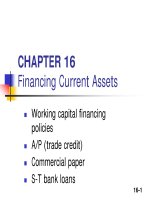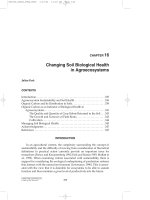Management ch 16 motivation
Bạn đang xem bản rút gọn của tài liệu. Xem và tải ngay bản đầy đủ của tài liệu tại đây (379.8 KB, 27 trang )
Chapter 16
Motivation
Motivation
One
secret for success in
organizations is motivated and
enthusiastic employees
With
such a diverse workforce, it is
a challenge for managers to
motivate employees toward
common organizational goals
Manager’s Challenge: Pfizer
2
Copyright © 2005 by South-Western, a division of Thomson Learning. All rights reserved.
Motivation
Employee
models
Topics
Chapter 16
motivation theories and
–Needs
–processes
–Reinforcement
How
job design can affect employee
satisfaction & productivity
Empowerment
3
Copyright © 2005 by South-Western, a division of Thomson Learning. All rights reserved.
Motivation
Arousal, direction, and persistence of behavior
Employee
motivation affects productivity
Part
of a manager’s job is to channel
motivation toward the accomplishment of
organizational goals
4
Copyright © 2005 by South-Western, a division of Thomson Learning. All rights reserved.
Two Types of Rewards
5
Intrinsic rewards--satisfactions a person receives in
the process of performing a particular action.
Extrinsic rewards--given by another person.
Copyright © 2005 by South-Western, a division of Thomson Learning. All rights reserved.
Model of Motivation
NEED-Creates desire to fulfill
needs (food, friendship,
recognition, achievement).
BEHAVIORREWARDS-Satisfy
Results in actions needs; intrinsic or
to fulfill needs.
extrinsic rewards.
FEEDBACK-Reward informs person whether behavior was
appropriate and should be used again.
6
Copyright © 2005 by South-Western, a division of Thomson Learning. All rights reserved.
Foundations of Motivation
Contemporary
Human Resources
• introduce the concept of the whole person
• employees are complex and motivated by
many factors
Human Relations
• noneconomic rewards, such as congenial
work groups
• workers studied as people and the concept
of social man was born
Traditional
7
• content theories stress the analysis of
underlying human need
• process theories concern the thought
processes that influence behavior
• reinforcement theories focus on employee
learning of desired work behaviors
•systematic analysis of an employee’s job
•economic rewards for high performance
Copyright © 2005 by South-Western, a division of Thomson Learning. All rights reserved.
Motivation Content Theories
Emphasize the needs that motivate people
8
Hierarchy of Needs Theory
ERG Theory
Two-Factor Theory
Acquired Needs Theory
Copyright © 2005 by South-Western, a division of Thomson Learning. All rights reserved.
Hierarchy of Needs
Theory
Abraham Maslow
Self-Actualization
Needs
represent the need for
self-fulfillment
Esteem Needs
desire for a positive self-image
and to receive attention
Human beings are
motivated by a
hierarchy of
unsatisfied needs.
Belongingness Needs
desire to be accepted by one’s peers
Safety Needs
safe and secure physical and emotional environment
Physiological Needs
most basic human physical needs
9
Copyright © 2005 by South-Western, a division of Thomson Learning. All rights reserved.
Maslow’s Hierarchy of Needs
Once a need is satisfied, it declines in importance
and the next higher need is activated
There are opportunities for fulfillment off the job and
on the job in each of the five levels of needs
Experiential Exercise: What Motivates You?
10
Copyright © 2005 by South-Western, a division of Thomson Learning. All rights reserved.
ERG Theory
Growth Needs
human potential,
personal growth, and increased
competence
Relatedness Needs
the need for satisfactory relationships
with others
Existence Needs
the needs for physical well-being
11
Copyright © 2005 by South-Western, a division of Thomson Learning. All rights reserved.
Two Factor Motivation
Theory
Area of Satisfaction
Motivators
Achievement
Recognition
Responsibility
Work itself
Personal
growth
Motivators
influence
level of
satisfaction.
Area of Dissatisfaction
Hygiene
Factors
Working conditions
Pay and security
Company policies
Supervisors
Interpersonal
relationships
12
Hygiene factors
influence level of
dissatisfaction
Copyright © 2005 by South-Western, a division of Thomson Learning. All rights reserved.
Acquired Needs Theory
David McClelland
• Need for Achievement desire to accomplish
something difficult, master complex tasks, and
surpass others
• Need for Affiliation desire to form close personal
relationships, avoid conflict, and establish warm
friendships
• Need for Power desire to influence or control
others
13
Copyright © 2005 by South-Western, a division of Thomson Learning. All rights reserved.
Motivation Process Theories
Equity Theory
14
focuses on individuals’ perceptions of how fairly
they are treated compared with others
motivated to seek social equity in the rewards
they expect for performance
Copyright © 2005 by South-Western, a division of Thomson Learning. All rights reserved.
Methods for Reducing
Perceived Inequities
15
Change inputs
Change outcomes
Distort perceptions
Leave the job
Copyright © 2005 by South-Western, a division of Thomson Learning. All rights reserved.
Motivation Process Theories
Expectancy Theory
16
motivation depends on individuals’ expectations
about their ability to perform tasks and receive
desired rewards
concerned not with identifying types of needs but
with the thinking process that individuals use to
achieve rewards
based on the effort, performance, and desirability of
outcomes
Copyright © 2005 by South-Western, a division of Thomson Learning. All rights reserved.
Reinforcement Perspective
on Motivation
Positive reinforcement in the
administration of a pleasant and
rewarding consequence.
Reinforcement
Tools
Avoidance learning is the removal of
an unpleasant consequence following
a desired behavior.
Punishment is the imposition of
unpleasant outcomes on an
employee.
Extinction is the withdrawal of a
positive reward, behavior is no longer
reinforced and hence is less likely to
occur in the future.
17
Copyright © 2005 by South-Western, a division of Thomson Learning. All rights reserved.
Schedules of Reinforcement
Continuous Reinforcement
Partial Reinforcement
Fixed-Interval Schedule
Fixed-Ratio Schedule
Variable-Interval Schedule
Variable-Ratio Schedule
18
Copyright © 2005 by South-Western, a division of Thomson Learning. All rights reserved.
Job Design for Motivation
19
Job design = application of motivational theories to
the structure of work for improving productivity and
satisfaction
Job simplification = job design whose purpose is to
improve task efficiency by reducing the number of
tasks a single person must do
Copyright © 2005 by South-Western, a division of Thomson Learning. All rights reserved.
Job Design for Motivation
20
Job Rotation = job design that systematically moves
employees from one job to another to provide them
with variety and stimulation
Job Enlargement = job design that combines a series
of tasks into one new, broader job to give employees
variety and challenge
Copyright © 2005 by South-Western, a division of Thomson Learning. All rights reserved.
Job Design for Motivation
21
Job Enrichment = job design that incorporates
achievement, recognition, and other high-level
motivators into the work
Work redesign = altering of jobs to increase both the
quality of employee’s work experience and their
productivity
Copyright © 2005 by South-Western, a division of Thomson Learning. All rights reserved.
Job Characteristics Model
Source: Adapted from J. Richard Hackman and G. R. Oldham, “Motivation through the Design of Work: Test of a Theory,” Organizational
22
Copyright © 2005 by South-Western, a division of Thomson Learning. All rights reserved.
Behavior and Human Performance 16 (1976), 256.
Motivational Ideas for Turbulent Times
Organizations are increasingly using various types of
incentive compensation as a way to motivate
employees to higher levels of performance
Variable compensation and forms of at risk pay are
key motivational tools
Ethical Dilemma: Compensation Showdown
23
Copyright © 2005 by South-Western, a division of Thomson Learning. All rights reserved.
Empowering People
to Meet Higher Needs
Four Empowering Elements
24
Information - Employees receive information about
company performance
Knowledge - Employees have knowledge and
skills to contribute to company goals
Power - Employees have the power to make
substantive decisions
Rewards - Employees are rewarded based on the
company performance
Copyright © 2005 by South-Western, a division of Thomson Learning. All rights reserved.
Continuum of Empowerment
Sources: Based on Robert C. Ford and
Myron D. Fottler, “Empowerment: A
Matter of Degree,” Academy of
Management Executive 9, no. 3 (1995),
21-31; Lawrence Holpp, “Applied
Emplowerment,” Training (February
1994), 39-44; and David P. McCaffrey,
Sue R. Faerman, and David W. Hart,
“”The Appeal and Difficulties of
Participative Systems,” Organization
Science 6, no. 6 (November-December
1995), 603-627.
25
Copyright © 2005 by South-Western, a division of Thomson Learning. All rights reserved.









